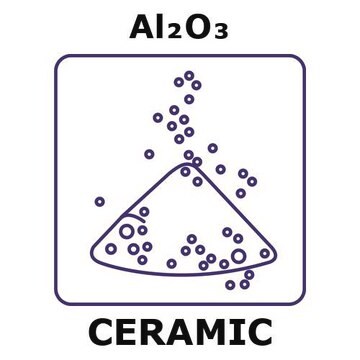Wichtige Dokumente
718475
Aluminiumoxid
nanopowder, 13 nm primary particle size (TEM), 99.8% trace metals basis
Synonym(e):
Aeroxide® Alu C, Aluminiumoxid
About This Item
Empfohlene Produkte
Qualitätsniveau
Assay
99.8% trace metals basis
Form
nanopowder
Oberflächenbereich
85-115 m2/g , BET
Primäre Partikelgröße
13 nm (TEM)
mp (Schmelzpunkt)
2040 °C (lit.)
SMILES String
O=[Al]O[Al]=O
InChI
1S/2Al.3O
InChIKey
TWNQGVIAIRXVLR-UHFFFAOYSA-N
Suchen Sie nach ähnlichen Produkten? Aufrufen Leitfaden zum Produktvergleich
Allgemeine Beschreibung
Anwendung
- Water-based nanofluids, which are used in engine cooling, heat exchangers, and nuclear cooling system. In graphene oxide/alumina nanofluid, the addition of aluminum nanoparticles improves the physical structure of graphene oxide and reduces the viscosity of the composite.
- Polysiloxane-aluminum oxide composites, applicable as an elastomeric thermal pad for light-emitting diodes.
Leistungsmerkmale und Vorteile
- Stable in a harsh non-biological environment.
- They can be easily prepared through established synthesis methods.
- A vast surface area allows conjugation with chemical and biological molecules.
- Their surface modification protocols are straightforward.
- They can easily interact with biological interfaces.
Lagerklassenschlüssel
13 - Non Combustible Solids
WGK
nwg
Flammpunkt (°F)
Not applicable
Flammpunkt (°C)
Not applicable
Hier finden Sie alle aktuellen Versionen:
Besitzen Sie dieses Produkt bereits?
In der Dokumentenbibliothek finden Sie die Dokumentation zu den Produkten, die Sie kürzlich erworben haben.
Kunden haben sich ebenfalls angesehen
Artikel
Hydrogen is one of the most important resources in providing food, fuel, and chemical products for our everyday life. Sustainable catalytic hydrogen production from bioethanol has gained significant attention in recent years due to globally diminishing fossil fuel supplies, which have necessitated the search for new chemical feedstocks.
A key challenge for nanomaterial safety assessment is the ability to handle the large number of newly engineered nanomaterials (ENMs), including developing cost-effective methods that can be used for hazard screening.
Among various ceramics, one-dimensional (1-D) piezoelectric ceramics have attracted significant scientific attention for use in energy harvesting.
Unser Team von Wissenschaftlern verfügt über Erfahrung in allen Forschungsbereichen einschließlich Life Science, Materialwissenschaften, chemischer Synthese, Chromatographie, Analytik und vielen mehr..
Setzen Sie sich mit dem technischen Dienst in Verbindung.



